Spotlight on the Indian Ocean
Spotlight on the Indian Ocean
2021 was another challenging year for hotels in the Indian Ocean. For countries whose economies heavily depend on tourism, the long-awaited reopening of borders to foreign visitors could not arrive soon enough. In this article we look at how websites have been performing for hotels in the Maldives, Mauritius and the Seychelles over the last 12 months and the opportunities to turn more lookers into bookers on hotel websites.
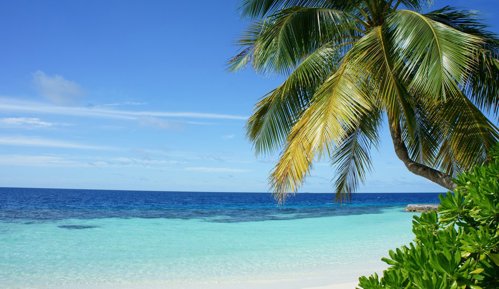
While the Maldives re-opened its borders to all travellers from July 2020 and the Seychelles in March 2021, citizens from many of the region’s biggest feeder markets were not permitted to travel. The Seychelles remained on the UK’s red list until October 2021 and Mauritius did not re-open to foreign visitors until 1st October 2021.
Pent up demand, reopening of flight routes, and heavily discounted hotel rates helped to drive up hotel website performance initially, but with waves of new Covid-variants arriving in major source markets, the picture was one of ups and downs.
WEBSITE SESSIONS
The Maldives successful positioning by nature of its resort style properties with widely spaced-out villas and restaurants made it the perfect escape for international visitors looking for a covid-safe destination. Average website sessions peaked at 37,000 in September 2021 with another smaller peak in January 2022.
Website sessions in Mauritius started to pick up from June onwards with news of borders reopening at the beginning of October, peaking the same month and then experiencing a slump in December with the arrival of the Omicron variant in many of its key markets, only to bounce back in January.
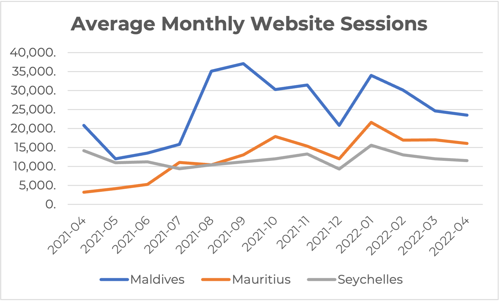
While website revenue started to peak for hotels and resorts in the Maldives and the Seychelles in Q3, 2021, Mauritius followed later with a peak in website revenue in October as international visitors began booking stays on the island. A dip in website revenue for all the destinations marked the arrival of Omicron and the resultant hesitancy in travel overseas, was just as quickly followed by a spike in January.
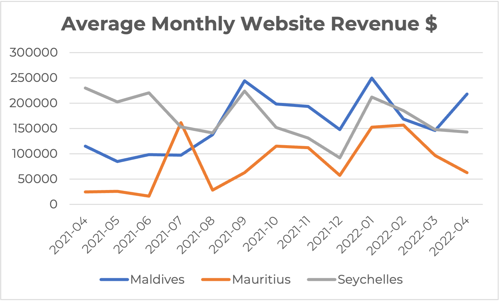
Conversion rate is one of the commonly used metrics to measure and evaluate a hotel’s website performance. In simple terms it is the number of bookings divided by the total number of sessions/visits and is a very good indicator for how well a hotel is converting a looker into a booker on their site. We analysed the average monthly conversion rate of hotels and resorts in the Maldives, Mauritius and the Seychelles between April 2021 and April 2022.
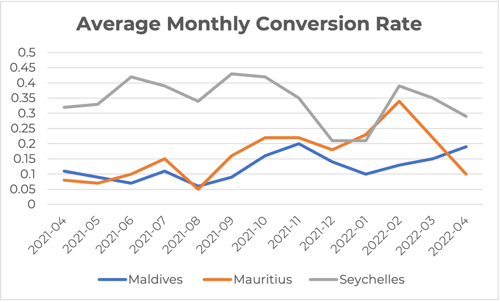
And then compared the average across the 13 months (April 2020 – April 2021) against three other countries.
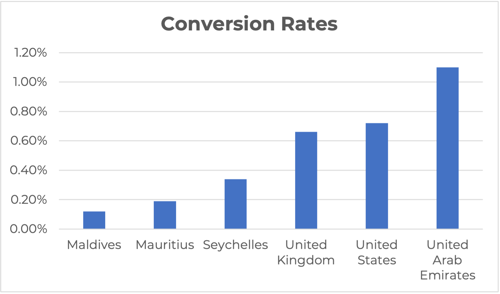
While low conversion rates can often be attributed to poor site user experiences, slow page loading times and confusing offers and content, there are other factors at play in destinations like the Maldives, Seychelles and Mauritius.
Holidays in luxury, long-haul destinations such as these are high-value purchases. Booking a hotel stay is not an impulsive decision. Customers tend to shop extensively, spending a lot of time researching before booking. First-time visitors are often unlikely to book during their first visit to your website, and often come back several times to conduct more research. Many will comprehensively research the hotel(s) on their short-list via the resort’s own websites but make the actual purchase via a third-party. These specialised tour operators package the hotel with air travel and transfers and given the uncertainty caused by the pandemic offer perceived flexibility in cancelling and rebooking along with financial protection. If we know that customers are unlikely to book on their first visit to the website, what can we do to personalise their experience at all points in their customer journey with calls to action to help increase conversions?
With hundreds of luxury hotels and resorts to choose between, knowing how to differentiate yourself from the competition in a destination where hotels are blessed with the same ocean, sunset, palm trees, beaches and sunshine is critical, and your website is the place to make these clear. Understanding your market position and points of difference is a prerequisite of staying competitive.
As travel rebounds, now more than ever it’s time for hotels to look at how to drive more bookings and revenue directly and to optimise conversion rates. Offering flexible cancellation and rebooking options and making sure these are communicated clearly on your website will help win back more direct business. Also be sure that guests know about your best-rate guarantee to beat any OTA prices and ensure you do not overwhelm visitors with the same message each time they visit your site. Time your ‘book direct’ message at exactly the right point in their customer journey.
Curating content that is personalised and speaks directly to what a customer might be seeking from their experience in your resort is essential. Customers want to see something they can personally relate to, or something they want to do or experience during their stay with you. What offers and packages do you have for different types of guests?
If you would like to begin enjoying Hotel Benchmark's free reports, signing up is easy here.
Categories:
Katrina has been working in the hospitality industry since 1993, more recently at Hotel Benchmark, uncovering insight from a wealth of data.


